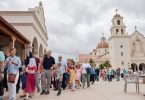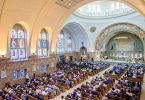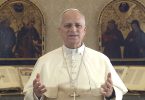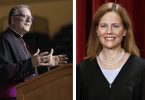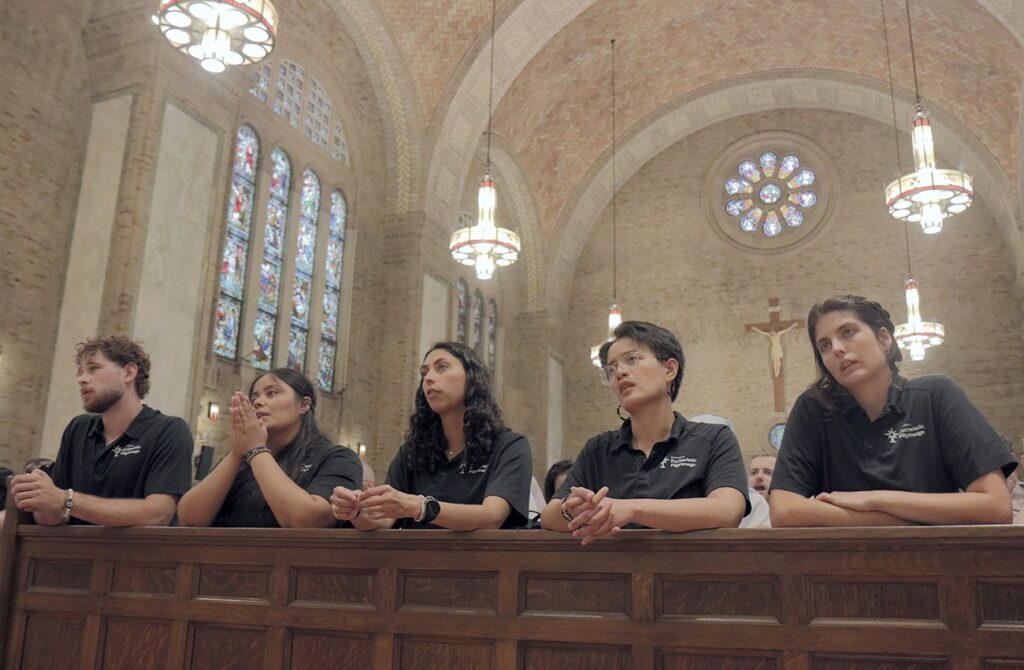
by Maria Wiering, OSV News
(OSV News) — On the feast of Corpus Christi June 2, perpetual pilgrims on the National Eucharistic Pilgrimage’s northern Marian Route were in the Minnesota Diocese of Winona-Rochester, which is led by Bishop Robert E. Barron —the bishop who, five years ago, first conceived of a national Eucharistic revival.
After noon-hour Eucharistic adoration in downtown Rochester at the diocese’s Co-Cathedral of St. John the Evangelist — which sits in the shadow of the city’s famed Mayo Clinic — Bishop Barron led hundreds in a half-mile procession to the Mayo Civic Center for Mass on the day the church particularly honors the reality of transubstantiation: the bread and wine truly becoming Jesus’ body and blood during Mass.
“We’re celebrating the Lord’s presence among us in the Eucharist,” Bishop Barron noted in a video posted to social media following the Mass. “It’s part of this revival that we bishops started a couple years ago just to remind everybody of the centrality of the Eucharist, the importance of the Eucharist. My prayer is that the whole country is lit with a Eucharistic fire.”
Known especially for his evangelization ministry Word on Fire, Bishop Barron was chairman of the U.S. Conference of Catholic Bishops’ Committee on Evangelization and Catechesis in 2019, when the Pew Research Center released a study that reported only one-third of Catholics believe the church’s teaching on the Eucharist. The study prompted Bishop Barron to float the idea of the National Eucharistic Revival, and the idea took shape under his successor, Bishop Andrew H. Cozzens of Crookston, Minnesota, with the addition of the National Eucharistic Pilgrimage and its destination, the National Eucharistic Congress in Indianapolis July 17-21.
In 2022, Georgetown University’s Center for Applied Research in the Apostolate revisited the topic of Catholic belief in the Eucharist with a more nuanced survey, and found almost two-thirds of Catholics believe in the Real Presence, but only 17% of Catholic adults attend Mass at least weekly.
On their third week of the pilgrimage, however, the perpetual pilgrims — young adults traveling the full lengths of the four National Eucharistic Pilgrimage routes with the Eucharist — reported meeting enthusiasm at every stop since setting out from points in California, Connecticut, Minnesota and Texas May 18-19.
“I’ve been edified by. . . people come out in droves to see our Lord, and even seeing people on the streets who, for the first time, you can just see the wonder on their face, like ‘what is this?’ And here we are, and Jesus is able to contact these people, maybe for the first time” in the Eucharist, said Blase Gebes, a perpetual pilgrim and seminarian from the Diocese of Rapid City, South Dakota, on a June 5 media call. “Seeing that is a sign of hope for me, and I think the church moving forward will see a true Eucharistic revival.”
On the pilgrimage’s eastern Seton Route, perpetual pilgrims and their chaplains spent May 30-June 3 in the Archdiocese of Philadelphia, where Archbishop Nelson J. Pérez led a Corpus Christi procession through downtown Philadelphia from the Cathedral Basilica of Sts. Peter and Paul to St. Patrick’s Catholic Church June 2.
In his homily at the cathedral prior to the pilgrimage, Seton Route chaplain Father Roger Landry of the Diocese of Fall River, Massachusetts, pointed to St. Thomas Aquinas’ liturgical sequence “Lauda Sion Salvatorem,” which had been chanted minutes earlier before the Gospel, saying it contains the essence of that day’s solemnity.
“We’re here today to fundamentally praise and thank Jesus Christ, our Good Shepherd, who accompanies us always in the holy Eucharist,” he said. “The mystery we celebrate is so much greater than all we could ever do and say. We’re called to pull out all the stops, to push ourselves way beyond our comfort zones because all our thanks, individually and combined, including all the saints that ever lived, all we can muster will be far short of what the incredible self-gift of Jesus in the holy Eucharist deserves.”
Two days later, the Seton pilgrims were in the Diocese of Harrisburg, Pennsylvania, walking in yet another public procession. “This pilgrimage is so radical and so crazy, and I’m glad that it is, because it’s a witness in and of itself,” Dominic Carstens, a perpetual pilgrim and student at Wyoming Catholic College, told The Catholic Witness, the diocesan newspaper.
“It makes people look at us and ask, ‘Why would they do this? Why would they give so much time and energy and sacrifice?'” he said. “I want them to ask those things, because then they can think for a moment and realize we’re out here because the Eucharist is truly Christ. I hope they see our love for the Lord, and that love makes them want to find
Christ, too.”
On June 5, the Seton Route pilgrims entered the Archdiocese of Baltimore, with a June 6 visit to the shrine of their route’s patron, St. Elizabeth Ann Seton, in Emmitsburg, Maryland, for Mass and a solemn procession.
Pilgrims on the southern Juan Diego Route marked the feast of Corpus Christi in the Archdiocese of Galveston-Houston, where Cardinal Daniel N. Dinardo celebrated Mass at St. Mary’s Cathedral Basilica in Galveston with a standing-room-only congregation June 2, and then led a mile-long Eucharistic procession.
Though the heat and humidity were nearly unbearable, save for a Gulf breeze that occasionally blessed those walking behind the monstrance, church officials estimated nearly 1,500 participants. Block by block, the procession moved among historical homes, with residents watching from their balconies and porches.
Earlier in the week, the southern route passed through Houston, home to perpetual pilgrim Camille Anigbogu. Throughout the weekend, she saw several friends and even former teachers, often unexpectedly, eliciting surprised hugs and greetings.
“I’m so glad to be back in Houston,” Anigbogu told the Texas Catholic Herald. “It reminds me of where I’m coming from and all of the people who have sacrificed and loved me over the years. I’m really glad that I’m getting to take that with me across the U.S. with my fellow Juan Diego route teammates and all the people who I’m going to encounter, all the Houston love.”
Following a meeting with Cardinal DiNardo, the pilgrims made for their maiden voyage on the Bolivar Ferry — a Galveston right of passage — heading for their final Texas stop June 2-3 in the Diocese of Beaumont, including adoration at its Christ Central Camp’s Blessed Carlos Acutis Chapel with Bishop David L. Toups.
On June 3, they crossed the border into Louisiana, journeying through the Diocese of Lake Charles before entering the Diocese of Lafayette in Louisiana June 5.
On the western Serra Route, pilgrims participated in a procession through the Uintah and Ouray Indian Reservation June 4 in Roosevelt, Utah, part of the Diocese of Salt Lake City, and also were introduced to the area’s vibrant Hispanic culture, said Maria Benes, the National Eucharistic Pilgrimage project lead for Modern Catholic Pilgrim, the Minnesota organization that partnered with the National Eucharistic Congress Inc., to create the pilgrimage.
The pilgrims gathered at the Utah Tribal Plaza, a travel stop on Highway 191, where Jerry C. Tapoof, a spiritual leader of the Ute tribe, welcomed them. “It is an honor to stand here amongst you. To see something good, to witness something good for myself.”
Tapoof blessed the pilgrims, first in the Ute language, then in English. “Bless them, that they can have something good; When they’re sleeping at night, give them something good to dream; help them in their everyday struggles, whatever it might be,” he said in part.
Tapoof then lit a length of braided sweetgrass with a lighter and walked with it around the pilgrims, blessing them with the smoke, which is a traditional Indian blessing. He gave the sweetgrass to Madison Michel, one of the pilgrims, “for your journey.”
Bishop Oscar A. Solis of Salt Lake City was the main celebrant of a Mass at the Fort Duchesne Community Center, concelebrated by two Franciscan Friars of the Renewal who were accompanying the pilgrimage that week. The bishop thanked the pilgrims for being part of “this wonderful spiritual journey in order to recapture our belief in the Real Presence of God; in order to regain a sense of awe, wonder and reverence in this great sacrament.”
Chas Firestone East, a Serra Route perpetual pilgrim from Virginia, called the pilgrims’ time with the Ute tribe a highlight of his week. He said its members used the analogy of a quilt to share “this idea. . . of the patchwork of this nation, and making sure there are no tears that cause the blanket to grow apart — really a good lesson on what it means to be a Christian neighbor.”
The Serra Route pilgrims left Utah June 4, driving through the Rocky Mountains with a June 5 stop in Steamboat Springs. They arrived in Boulder June 6 for Eucharistic adoration at the University of Colorado Boulder before heading to Arvada and Littleton June 7.
After three weeks in Minnesota, the Marian route pilgrims prepared to process into Wisconsin June 7, with Bishop Barron expected to hand off the Eucharist in a monstrance to Bishop Gerard W. Battersby, who was installed as head of the Diocese of La Crosse May 20, before processing to a local arena for Mass and large revival gathering called “The Answer.”
On his Corpus Christi social media video, Bishop Barron asked for prayers for the upcoming National Eucharistic Congress. “Pray,” he said, “that it gives the whole church a Eucharistic inspiration.”

